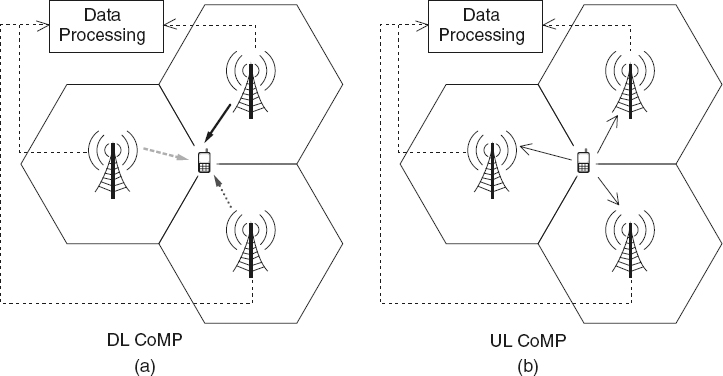Coordinated Multi-Point (CoMP) Transmission
The performance of cell-edge users is known to be interference-limited. This has been an unavoidable situation for all previous generations due to the inherent per-cell processing. In other words, since a MS can be only affiliated with one BS at a time, except for the duration of the soft handover process, cell-edge users will be prone to interference from neighboring cells. Consequently, their SINR will be reduced in proportion to the interference level, which directly lowers their achievable capacity. This has been traditionally dealt with by proper resource management between neighboring cells, for example, fractional FR.
Figure 2.11 DL and UL CoMP techniques.
A radical shift in this cell-centric processing has been recently made through CoMP techniques [11]. CoMP refers to a family of techniques through which the UL and/or the DL transmissions can be simultaneously managed by multiple neighboring BSs as shown in Figure 2.11.
In doing so, CoMP aims at exploiting rather than mitigating inter-cell interference, hence forming a distributed multiple antenna system. By coordinating and combining signals from multiple BSs, CoMP makes it possible for MSs to enjoy consistent performance and QoS when they access and share videos, photos and other high-bandwidth services regardless of their remoteness from the BS. Hence, CoMP techniques improve the cell coverage; enhance the cell-edge throughput, and the overall system efficiency.
As shown in Figure 2.11, CoMP involves multiple, geographically dispersed BSs connected to a central processing unit. This unit is responsible for UL and DL transmission coordination. Despite the very limited literature on these promising techniques, a few CoMP scenarios can be identified.
Interference Cancellation
This is a basic DL CoMP technique. It aims at reducing the amount of interference experienced by cell-edge users through coordinating CSI between the BSs. In particular, if the BSs can share the CSI of their served MSs through the network backhaul, then this information can be used to eliminate (or at least reduce) the inter-cell interference through controlling user scheduling, power allocation and beamforming parameters. This type of CoMP is referred to in [10] as interference coordination. Observe that this basic form of CoMP is still intending to mitigate interference rather than exploiting it.
Single Point Feedback/Single Point Reception
In this type of CoMP, terminals are not aware that transmissions are originating from multiple, geographically separated BSs. The terminal only performs basic measurements and reports it to the serving BS. Based on the channel quality perceived on the user side, the network decides which base station is better suited to transmit to the receiver. For channel estimation, terminal-specific references signals are used. Due to the diversity gain (resulting from the selection of the best candidate transmitter), power is improved. Such a setup would allow for backward compatibility with legacy systems.
Multichannel Feedback/Single Point Reception
The mobile terminal's awareness under multichannel feedback/single point reception is higher than that of single channel feedback. Here, the mobile terminal reports the channel status feedback not only for the serving base station, but also for other bases stations from which it is able to distinguish a DL channel. However, the terminal would still be unaware of the exact processing taking place in the network, and its processing would be the same as that made for single channel feedback/single point reception CoMP.
Multichannel Feedback/Multipoint Reception
The multichannel feedback/multipoint reception setup means a more involved mobile terminal. Here, the terminals are made aware of how the coordination setup, for example, from which base station is it expected to receive a transmission, and can use this information for coordinated multipoint reception. This technique mitigates interference and results in higher SINR values for the network. The disadvantage of this setup, however, is that it requires additional signaling the DL to relay the information for the coordinated transmission.
Inter-Cell MIMO
Probably, the most general form of CoMP is the so called cooperative MIMO or multi-cell MIMO. In this scenario, a group of BSs jointly coordinate the UL and DL communication with a group of MSs. Hence, multi-cell MIMO can be seen as a generalization of the aforementioned MU-MIMO. Depending on the processing efficiency, available capacity, and existing delays, varying levels of MS data can be exchanged between a group of BSs. At one hand, exchanging the CSI of the MSs between the various BSs helps mitigating inter-cell interference. On the other hand, exchanging the MS's traffic between the various BSs allows better reception, reduced or even eliminated inter-cell interference, and better QoS provisioning to all cell-edge users.

